ISIL’s ‘media behemoth’ has left western powers floundering trying to counter its propaganda, a new report has concluded. The study, published by
ISIL’s ‘media behemoth’ has left western powers floundering trying to counter its propaganda, a new report has concluded.
The study, published by counter-terrorism think tank Quilliam Foundation, found the ‘quantity, quality and variation’ of the extremists’ media output dwarfed that of governments or groups trying to challenge them.
It monitored ISIL’s media machine for a month over this summer, finding it put out 1,146 pieces of propaganda on average, or 38-a-day.
Britain’s counter-jihad Twitter handle, @UKAgainstISIL, by contrast, produced 36 original tweets in its first month of operation.
“In many respects ISIL is operating like a media company,” said Haras Rafiq, managing director of Quilliam. “Our response has to be proportionate. We must realise that there is no elixir that can deliver us from ISIL’s information supremacy, no catch-all counter-narrative to undercut its carefully-cultivated and choreographed image.”
Report author Charlie Winter, a senior jihadism researcher, said: “Though there are some commendable efforts being undertaken by counter violent extremism practitioners and civil society organisations, they are dwarfed in size by ISIL’s media behemoth, which produces on average 38 individual batches of propaganda each day – videos, photo essays, articles and audio programmes.
“Apart from the practicalities, the counter effort is, from the offset, structurally impaired from success. Indeed, the cult of the counter-narrative has left coalition partners working from within a reactive paradigm, something that means it is perpetually on the back foot when it comes to presenting an alternative to what ISIL offers.
“ISIL’s vast propaganda operation is unrivalled, involving devoted media teams from West Africa to Afghanistan who work relentlessly, day and night, in the production and dissemination of the ‘caliphate’ brand. So far, most of our attempts to meaningfully mitigate ISIL’s ability to globally engage have been left floundering.”
ISIL has gained notoriety in the West for its slickly-produced videos of beheadings but Quilliam’s study found more than half of its propaganda over the month (July 17- August 15, 2015) depicted civilian life in territory held by the extremists.
“Economic activity, social events, abundant wildlife, unwavering law and order, and pro-active pristine religious fervour form the foundations of ISIL’s civilian appeal,” said the report, ‘Documenting the Virtual Caliphate’. “ISIL still markets itself with brutality. However, the intended target audiences for its ultraviolence are decidedly more regional than they have been previously. It seems that fostering international infamy could now be second to intimidating its population with a view to discouraging rebellion and dissent.”
ISIL’s videos, pictures and audio are put out by several of its affiliated media groups, including the Ajnād Foundation, A’maq News Agency and al-Hayat Media Centre, the latter targeting English-speaking audiences.
ISIL’s propaganda is thought to have contributed to an estimated 4,000 Europeans going to fight in Syria and Iraq.
ISIL also relies on supporters to share its message, according to a report by The Brookings Institution. It claimed 46,000 Twitter accounts were used by ISIL allies between September and December 2014.
